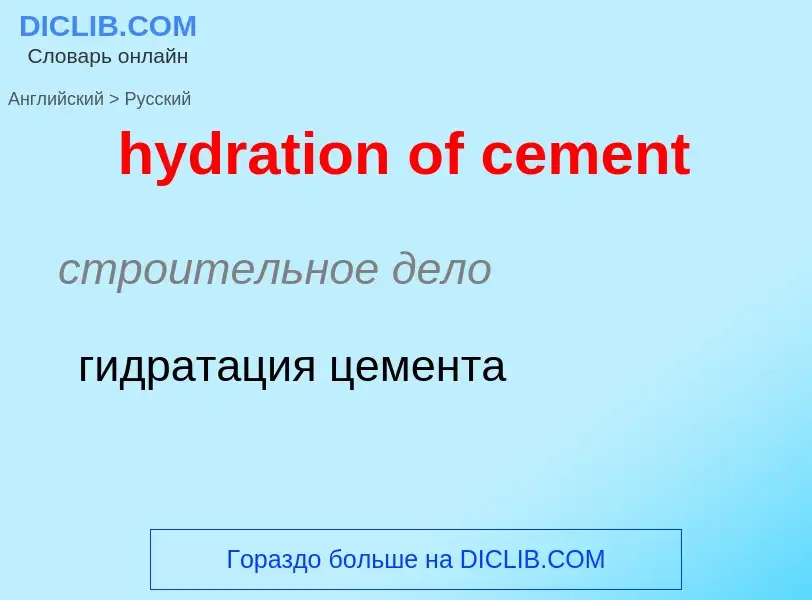Перевод и анализ слов искусственным интеллектом ChatGPT
На этой странице Вы можете получить подробный анализ слова или словосочетания, произведенный с помощью лучшей на сегодняшний день технологии искусственного интеллекта:
- как употребляется слово
- частота употребления
- используется оно чаще в устной или письменной речи
- варианты перевода слова
- примеры употребления (несколько фраз с переводом)
- этимология
hydration of cement - перевод на русский
строительное дело
гидратация цемента
нефтегазовая промышленность
волокнистый цемент
нефтегазовая промышленность
волокнистый цемент
строительное дело
вода гидратации
нефтегазовая промышленность
гидратационная вода
строительное дело
соотношение водо-цементное
нефтегазовая промышленность
водоцементный фактор, водоцементное отношение
нефтегазовая промышленность
водоцементное отношение
Определение
.
Википедия

A cement is a binder, a chemical substance used for construction that sets, hardens, and adheres to other materials to bind them together. Cement is seldom used on its own, but rather to bind sand and gravel (aggregate) together. Cement mixed with fine aggregate produces mortar for masonry, or with sand and gravel, produces concrete. Concrete is the most widely used material in existence and is behind only water as the planet's most-consumed resource.
Cements used in construction are usually inorganic, often lime or calcium silicate based, which can be characterized as hydraulic or the less common non-hydraulic, depending on the ability of the cement to set in the presence of water (see hydraulic and non-hydraulic lime plaster).
Hydraulic cements (e.g., Portland cement) set and become adhesive through a chemical reaction between the dry ingredients and water. The chemical reaction results in mineral hydrates that are not very water-soluble and so are quite durable in water and safe from chemical attack. This allows setting in wet conditions or under water and further protects the hardened material from chemical attack. The chemical process for hydraulic cement was found by ancient Romans who used volcanic ash (pozzolana) with added lime (calcium oxide).
Non-hydraulic cement (less common) does not set in wet conditions or under water. Rather, it sets as it dries and reacts with carbon dioxide in the air. It is resistant to attack by chemicals after setting.
The word "cement" can be traced back to the Ancient Roman term opus caementicium, used to describe masonry resembling modern concrete that was made from crushed rock with burnt lime as binder. The volcanic ash and pulverized brick supplements that were added to the burnt lime, to obtain a hydraulic binder, were later referred to as cementum, cimentum, cäment, and cement. In modern times, organic polymers are sometimes used as cements in concrete.
World production is about four billion tonnes per year, of which about half is made in China. If the cement industry were a country, it would be the third largest carbon dioxide emitter in the world with up to 2.8 billion tonnes, surpassed only by China and the United States. The initial calcination reaction in the production of cement is responsible for about 4% of global CO2 emissions. The overall process is responsible for about 8% of global CO2 emissions, as the cement kiln in which the reaction occurs is typically fired by coal or petroleum coke because a luminous flame is required to heat the kiln by radiant heat transfer. As a result, the production of cement is a major contributor to climate change.




![The National Cement Share Company of [[Ethiopia]]'s new plant in [[Dire Dawa]]. The National Cement Share Company of [[Ethiopia]]'s new plant in [[Dire Dawa]].](https://commons.wikimedia.org/wiki/Special:FilePath/Factory of National Cement Share Company.jpg?width=200)
![Clinker]] nodules produced by sintering at 1450 °C. Clinker]] nodules produced by sintering at 1450 °C.](https://commons.wikimedia.org/wiki/Special:FilePath/LDClinkerScaled.jpg?width=200)
![page=[https://archive.org/details/isbn_9781616144814/page/190 190]}}</ref> page=[https://archive.org/details/isbn_9781616144814/page/190 190]}}</ref>](https://commons.wikimedia.org/wiki/Special:FilePath/William Aspdin Radford cyclopedia Volume 1.jpg?width=200)
 (cropped).jpg?width=200)



![Older fibre cement roofing. [[Rammu]] island in Estonia Older fibre cement roofing. [[Rammu]] island in Estonia](https://commons.wikimedia.org/wiki/Special:FilePath/Rammu Kiini hooned.jpg?width=200)

![Hydrated [[copper(II) sulfate]] is bright blue. Hydrated [[copper(II) sulfate]] is bright blue.](https://commons.wikimedia.org/wiki/Special:FilePath/Copper sulfate.jpg?width=200)

